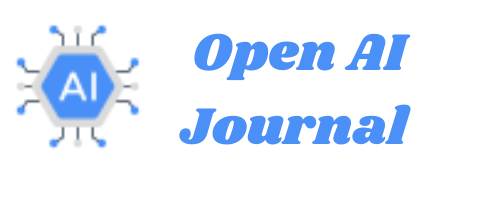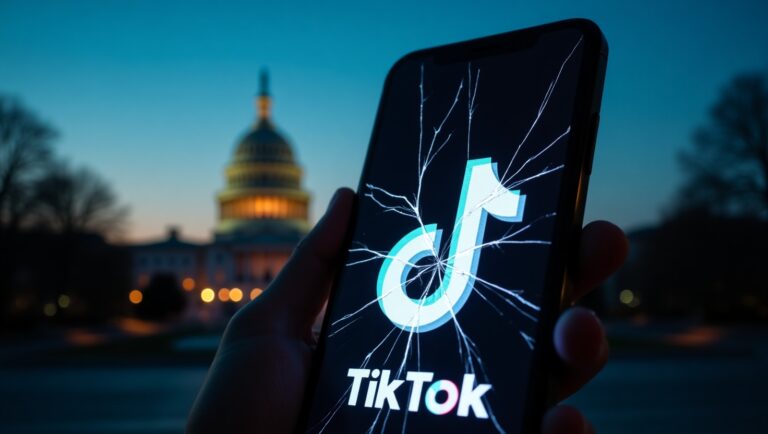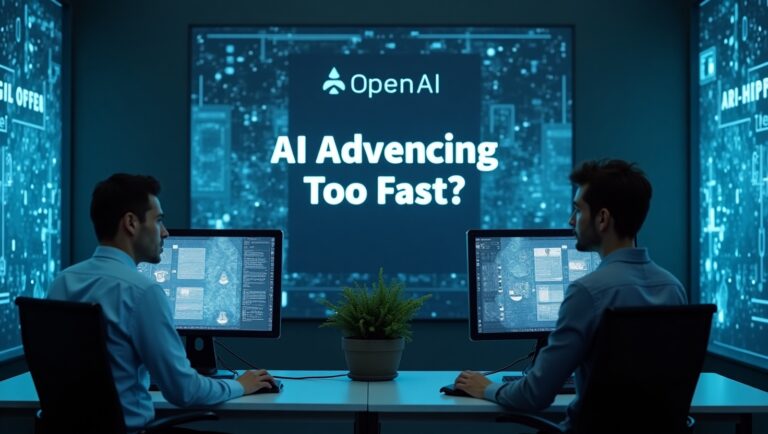AI Wrappers Are Taking Over: Innovation or Illusion?
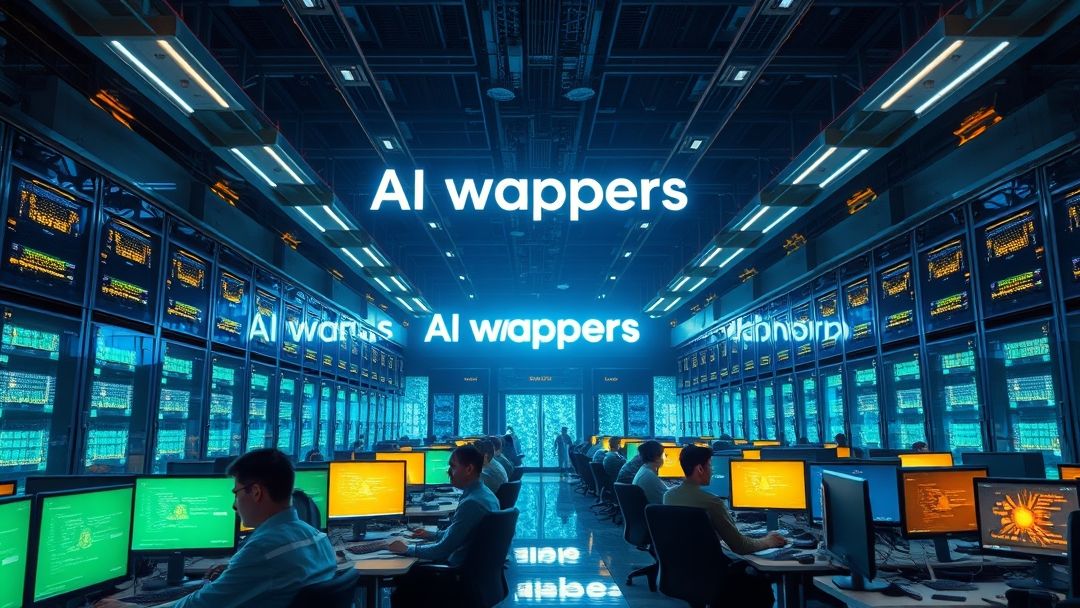
Table of Contents
Introduction: They’re everywhere—but you might not even realize it.
In the fast-evolving world of generative AI, a quiet revolution is reshaping how we interact with machine intelligence. It’s not coming from OpenAI, Google, or Meta directly. Instead, it’s emerging from a shadow layer of innovation built on top of these giants—sleek, simple apps powered by AI engines under the hood. They’re called AI wrappers, and they’re taking over your browser, your workflow, your business… and maybe even your job.
From one-click content generators to hyper-specific productivity bots, AI wrappers promise to make the complex world of artificial intelligence beautifully accessible to the masses. No code. No jargon. Just results. But behind the glossy interfaces lies a growing controversy—are these tools a true leap in user empowerment, or just digital illusions riding the coattails of more powerful technologies?
In this deep dive, we peel back the layers of the AI wrapper boom to expose what’s real, what’s risky, and what’s quietly reshaping the tech industry. Are AI wrappers the future of software? Or are we witnessing the rise of a fragile ecosystem built on borrowed intelligence?
Get ready—we’re about to unwrap the truth.
1. The Rise of AI Wrappers: A Silent Software Revolution
Just a couple of years ago, very few people had even heard the term “AI wrapper.” Today, they’re quietly reshaping the entire software world. It all began when LLM providers like OpenAI, Anthropic, and Google started offering powerful APIs. Suddenly, developers realized they didn’t need to train massive models themselves—they could simply wrap existing AI capabilities in clever interfaces and workflows.
This isn’t speculation. According to McKinsey, generative AI could contribute between $2.6 trillion and $4.4 trillion annually across global industries. Within that enormous space, niche AI wrappers are carving out profitable microcosms—targeting verticals like legal, healthcare, education, and finance. Accenture’s research shows that declining API costs and mature SaaS deployment models have made these tools more economical than ever .
What’s fascinating is how stealthy this revolution has been. Most of these apps don’t burn with press coverage. They launch quietly on Product Hunt, Twitter, or Reddit, steadily attract paying users, and scale behind the scenes. A LYNKSPHERE report from April 2025 shows tools like PhotoAI ($77K MRR), Chatbase ($70K), InteriorAI ($53K), and PDFai ($30K) dominating the space . That’s millions funneled into simple wrappers—no original model training, just brilliant UX and positioning.
This silent revolution has parallels to the early days of cloud computing: few saw it coming, but today, you’d be hard-pressed to run a startup without it. AI wrappers are becoming just as foundational—quietly embedding themselves in workflows that power millions of real human tasks every day.
2. What Exactly Is an AI Wrapper?
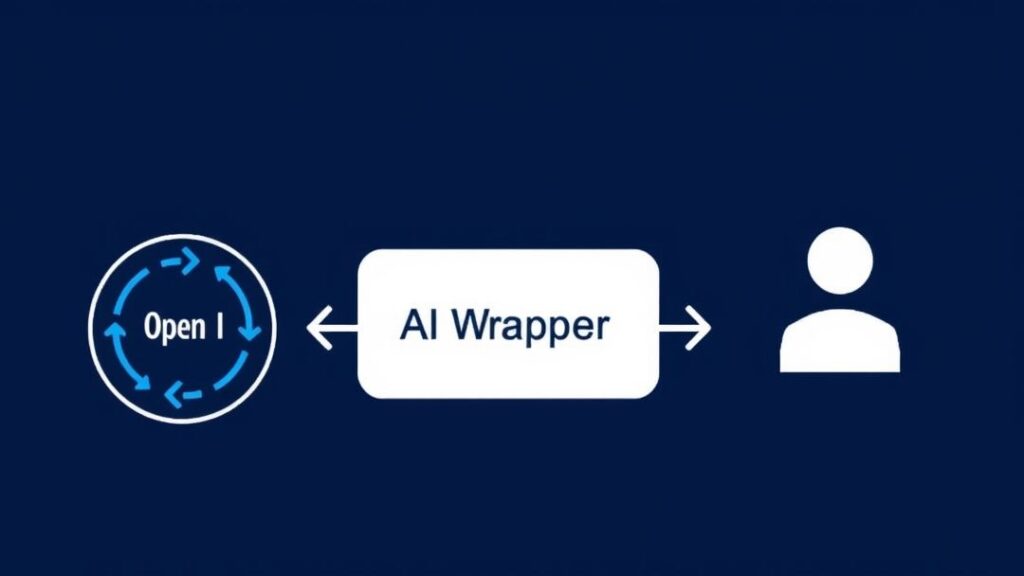
Let’s cut to the chase: an AI wrapper is a thoughtfully designed package built around a powerful AI model like GPT-4 or Claude. It includes a user-friendly front end, tailored prompts, automations, and a billing mechanism. In essence, it’s a solution that removes friction from raw APIs to serve a real user need.
Imagine a flow like this:
| Component | Description |
|---|---|
| Foundation Model | Externally sourced (e.g., GPT-4, Claude) |
| Prompt Logic | Pre-defined or dynamically constructed prompts tailored to tasks |
| Frontend UI | Web/mobile app built with tools like Bubble, React, or Flutter |
| Automation Layer | Zapier or Make.com integrations for workflow automation |
| Billing System | Subscription-based, usage-based, or tiered pricing |
The magic is in how these pieces fit together. On the surface level, it might seem like a GPT-enabled app with a nice look and feel—and sometimes that’s all there is. But the real art lies in understanding your audience’s exact needs, guiding them through a frictionless experience, and, often, combining multiple data sources (like knowledge bases or user uploads) into the AI funnel.
As Every’s Alex Duffy explained: “take your subject-matter expertise, combine it with increasingly powerful AI, and build a tool that helps people achieve their goals” . The simplicity is deceptive—what looks like a weekend hobby often involves months of iteration on UI flows, business logic, and domain knowledge.
That said, an AI wrapper is not a full-stack AI system. It’s an application leveraging someone else’s model. Yet, ironically, that positioning grants wrapper creators a leg-up in distribution, UX insight, and domain-specific solutions—often outperforming giant AI providers in these areas.
3. Why AI Wrappers Are Printing Money
There’s a short answer to why AI wrappers are so profitable: speed, UX, and monetization leverage. But let’s break this down in detail.
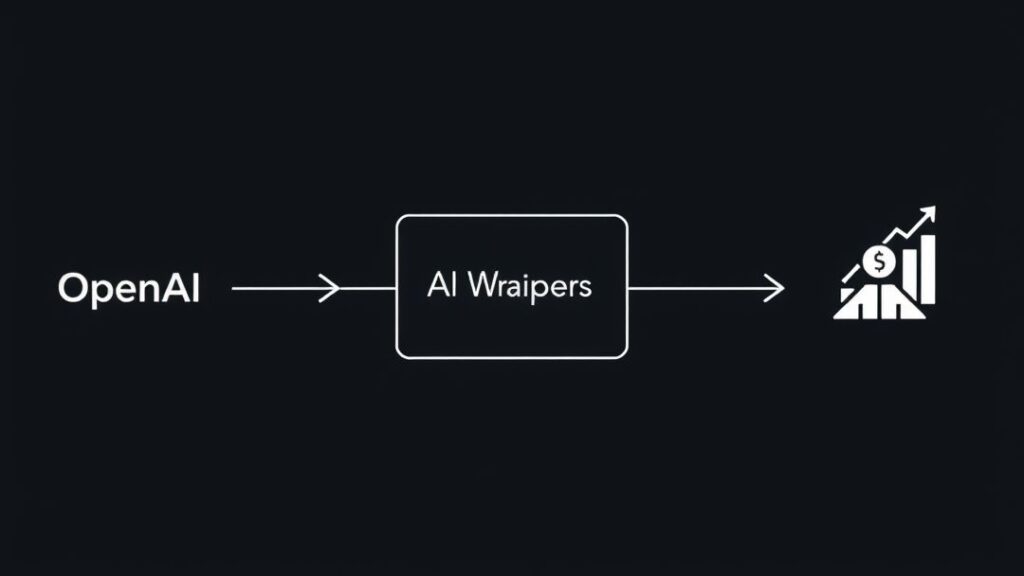
Speed to Market
You no longer need a month of R&D to build an AI product. With an API key and a no-code tool, someone can launch an MVP in a week. IndieHackers report: Summarify.me hit 4.7K signups, 25K visits, and $220 MRR within weeks of launch. That same model scales—FormulaBot reached $40K MRR by automating Excel formula creation .
Vertical Focus = Value
Look at the numbers from AppFigures: third-party “thin wrappers” in the app stores are projected to generate $726 million in 2025 . That’s over 35% of the entire AI app revenue, dwarfing even core model apps.
| Category | 2025 Gross Revenue Estimate |
|---|---|
| Thin Wrappers | $726M |
| Core Model Apps | $541M |
| Graphics Generators | $210M |
| Utilities | $69M |
Thin wrappers—often less technically ambitious than generative art or core AI model apps—are monetizing faster and at scale.
Lean Economics
Unlike model providers that spend billions on R&D and infrastructure, wrapper apps have low operational costs—mostly APIs, hosting, and marketing. Many report 70–80% gross margins on that model.
Take PhotoAI: a single niche vertical and it hit $55K MRR with minimal overhead.
User Psychology
Wrapping solves real human pain points. People don’t want to learn prompting—they want answers. Aimed at non-technical marketers, small business owners, or creators, wrappers bundle the AI intelligence into accessible, clickable use-cases that spark immediate “aha” moments. Pay $30/month for a tool that writes a legal contract or summarizes video content—and people pay.
4. The Ethics Debate: Is It Innovation or Intellectual Theft?
With great speed often comes controversy—and AI wrappers aren’t immune. Let’s explore both sides seriously.
The Critics: “This Is Just Reselling”
Many outspoken developers call wrappers lazy or unethical. On Reddit, several have echoed this: “It feels like dropshipping for devs”—slapping a new interface onto someone else’s intellectual property and charging a premium . Critics argue that without unique models or proprietary data, wrappers are little more than glorified switches that add little long-term value.
The unit economics, too, raise red flags. LinkedIn posts warn of the razor-thin margins when API costs climb. Some wrappers spend 20–40% of revenue on inference, leaving little buffer for growth . Once OpenAI or Claude improves free usage or builds features natively, wrapper businesses could collapse overnight.
The Defenders: “This Is Real Innovation”
On the other hand, defenders say wrappers are at the cutting edge of human-centered design. Every’s Alex Duffy outlines how subject-matter experts can incubate wrapped tools that elevate specific workflows . A no-code creator doesn’t need to build a model—they just need to get AI into users’ hands meaningfully.
And investors are listening. The FT reports that AI application startups—not raw model developers—received $8.2 billion in funding in 2024, more than doubling the previous year . Companies like Cursor, Perplexity, and Harvey have achieved up to $200 million ARR in under two years . These numbers show that the market values wrapper-driven UX innovation—even over core model complexity.
Nuance: Ethics vs. Sustainability
- Ethical concern: Is it wrong to charge for a thin layer on someone else’s tech? Critics say yes.
- Value assessment: Is the UI, workflow, and domain nuance enough to justify a product? For paying users, often yes.
- Long-term moat: Sustainable wrappers need proprietary data, deeper models, or rich integrations—not just a prettier UI.
Some wrappers are investing in data collection and model fine-tuning—building defensibility beyond API integration. Others are experimenting with meta-app layers, routing users across contexts and reducing friction with multiplatform UIs .
5. The Developer Divide: Coders vs. Clickers

Have you ever felt caught between two worlds in the tech universe? On one side, the traditional coders—architects of systems, lifelong learners of languages, debuggers of the arcane—and on the other, the rising “clickers,” empowered by no-code platforms and API-driven tools that promise to build real software without writing a line. With AI wrappers, this divide has become sharper than ever.
Traditional coders often view AI wrappers as superficial—mere skins over powerful models—with no deep engineering, no original algorithms, and no real architecture. To them, wrapping a prompt with a sleek UI is a shortcut, perhaps even an insult to what they consider genuine software craftsmanship. They say such tools lack robustness, scalability, or innovation. Many of them grumble on Hacker News or Reddit that wrappers are nothing more than glorified, disposable scripts waiting to break.
Yet the clickers come back with an unapologetic embrace of pragmatism. Why spend months or years building internally from the ground up when you can stand on the shoulders of powerful foundation models? With tools like Bubble, Glide, and Softr, anyone—developer or not—can compose a full-fledged AI‑powered app in days. For them, the value lies first in solving user problems, not rewriting ChatGPT.
This conflict mirrors a broader shift in the software world. It’s no longer “code is king.” Distribution, user experience, and domain knowledge have grown at least as valuable. In fact, a recent FT study found that startups building AI applications—not the models behind them—attracted more than $8.2 billion in funding in 2024, dwarfing the earlier focus on model‑centric startups . That shows investors see more value in wrapped apps delivering human‑centered tools than in reinventing the model wheel.
Here’s a breakdown of community sentiment:
| Group | Core Belief | Values |
|---|---|---|
| Coders | Engineering = innovation | Depth, robustness, architecture, code maturity |
| Clickers | Distribution = innovation | Speed, UX, vertical focus, adaptability through tools |
Whether you think wrapping a model is lazy or brilliant depends largely on your values. But one thing’s clear: AI wrappers are forcing a redefinition of what it means to build software. And as models become commodities, that redefinition becomes more urgent.
6. AI Wrapper Failures: When the Illusion Breaks
Talk to any AI wrapper creator, and you’ll hear dreams of fast traction and subscription revenues. But many of these founders have stories of flashing lights and dramatic fades. In fact, an estimated 90% of AI startups fold within the first year, and wrappers are no exception .
Why do so many fail? Because at the heart, most wrappers are thin. They rely entirely on generic model outputs and can’t handle the messy variability of real users. One minute they’re trending on Product Hunt; the next, their server is throttling, they hit usage caps, and the UI falls apart under real feedback. Users realize they can get nearly the same result by pasting prompts into ChatGPT or Claude directly.
We can see this in a breakdown of failed wrapper startups:
| Failure Cause | Example Impact |
|---|---|
| Token Costs Spikes | Founders spent 30–40% of revenue on API calls, leaving little for dev or UX |
| Thin Value Proposition | Users churn once novelty wears off—no unique workflows or data integration |
| Poor Infrastructure | Server bottlenecks, variant input failures under load |
| Model Dependency | When providers adjust pricing or throttle access, wrappers collapse |
One standout example is SummarifyPro, which amassed 8K users in its first month. Yet two months later they had to shut down due to prohibitive per-token costs—despite initial growth. Similarly, StartupPitch.AI boomed with 10K signups in three days, but fell flat when it couldn’t scale beyond productized prompts and a thin UI.
Medium’s “The Graveyard of AI Startups” recounts how wrapper creators crashed when founders tried to fund marketing before refining the product. What looked like a clever wrapper often proved to be no product at all.
In the end, many wrappers die because they never graduated from proof‑of‑concept. They didn’t build a sustainable business, acquire proprietary data, or architect infrastructure that could gracefully handle real users over time. The brutal lessons: novelty isn’t value, scalability matters, and relying solely on someone else’s model is a house of cards.
7. Big Tech’s Quiet Crackdown on Wrappers
Here’s a surprising twist: over the last year, some wrapper startups have quietly found their OpenAI accounts disabled. It seems foundation-model companies are starting to police the ecosystem—not for moral high ground, but for control.
There are two forces at work here. First, many wrappers were riding uncomfortably close to violating terms of service—whether via data scraping, prompt extraction, or non‑compliant data handling. A recent IT Brief report warns of “HTML prompt wrappers masquerading as SaaS,” noting that they offer little beyond slick UI and basic API calls . Providers are also under pressure to enforce compliance and data-residency rules.
Second, big AI players have begun to replicate the best wrapper functions within their own platforms. OpenAI’s GPTs, Claude’s tools, and Anthropic’s plugin system are all essentially wrappers baked in. This naturally threatens indie wrappers that charge $20‑$100/month. Once baseline wrapper features become free, wrapper startups must innovate deeper or lose relevance.
There were also geopolitical moves. In mid–2024, OpenAI blocked API access in regions without compliance infrastructure. That spurred massive migration to local alternatives like Baidu’s Ernie and Alibaba’s Qwen, but also sent a signal: foundation‑model access is a privilege, not a right .
Meanwhile, developers like Jon Warner warn that the AI-wrapper boom is on shaky ground: “most AI startups today are superficial wrappers… If the wrapper ecosystem collapses… OpenAI loses its main distribution channel” . Big Tech knows that—and they’re quietly fortifying the perimeter.
In short, wrappers are collateral damage in the battle for control, compliance, and monetization. And their quiet crackdown is already shrinking the ecosystem.
8. How YOU Can Build an AI Wrapper Today (Without Coding)
Okay, so maybe you’ve read the warnings and still feel a spark of excitement. Good—you should. Building a simple AI wrapper remains more accessible than ever, even with no-code tools. But success now demands smart execution. Let’s walk through how you can build a robust wrapper—and avoid the pitfalls.
Step 1: Pinpoint a High-Value Use Case
Anyone can create a “chat with AI” tool. But value comes from domain-specific workflows. So look for niches: podcast episode summarizer, legal NDA generator, local SEO blog writer. According to SaaS Design, focusing on your own frustrations gives the best product‑market fit.
Step 2: Choose Your No-Code Stack
Start with something like:
- Frontend/UI: Bubble, Glide, Hostinger Horizons
- Backend Workflows: Zapier, n8n, Make.com
- Database & Hosting: Firebase Studio, Supabase
- AI Connection: OpenAI or Anthropic API key
Neil Phan’s guide shows you can go from empty canvas to working app in one weekend using Firebase + n8n .
Step 3: Build Your Prompt Engine
This is the tricky part. Good prompts make or break your wrapper. Use few-shot examples, guardrails, validation checks. Test repeatedly with real inputs. Medium’s “Create your own ChatGPT wrapper” tutorial shows how quick iterations can tune performance.
Step 4: Add a Thin But Valuable Layer
Don’t just let the model spit answers. Enhance it with:
- Input sanitization
- Hierarchical or chained prompts
- Specific output formats (e.g., markdown, bullet points)
- Optional data uploads (PDFs, text snippets)
Aim to create a little bit of proprietary logic—whether business rules, templates, or API integrations.
Step 5: Monetize Smartly
Charge based on usage thresholds:
| Plan | Features | Price |
|---|---|---|
| Free Tier | 5 uses/month | $0 |
| Standard | 100 uses + email support | $19/month |
| Pro | 1,000 uses + CSV, API access | $49/month |
Always benchmark against the underlying token and hosting costs to ensure at least 60% gross margin.
Step 6: Launch, Learn, Iterate
Deploy early. Share it on Maker News, IndieHackers, Twitter, relevant subreddits. Gather feedback. Improve UX, add tutorial copy. According to SaaS Design and Bubble guides, speed matters more than polish .
Step 7: Build a Defensible Layer
Beyond MVP, you should:
- Cache answers or user data
- Collect anonymized usage data for fine‑tuning
- Create email workflows or integrations
- Plan for portable input/output (e.g., export, templates)
If OpenAI or Big Tech replicates your wrapper logic, your moat lies in vertical expertise, data, embedding layers—something that anonymized prompt engineering alone can’t replicate.
9. The Future of AI Wrappers: Boom, Bubble, or Burnout?
If you look at today’s AI landscape, it feels like we’re teetering on the edge of something huge—and maybe fragile. The generative AI market is exploding, with Statista forecasting a market value near $67 billion in 2025, and projections pushing it to $1.8 trillion by 2030 . That’s a level of exponential growth that hasn’t been seen since the smartphone revolution.
AI wrappers sit at the intersection of this boom. They make raw AI accessible, wrapping complex LLM capabilities into niche, user-friendly apps. Yet beneath the hype, there’s growing concern that this model may not last. On Wall Street, economists like Torsten Sløk at Apollo Global are openly warning that an AI bubble may be forming—one potentially even more dangerous than the dot-com crash . At the same time, Eric Schmidt counters that AI isn’t a passing fad—it’s a whole new industrial backbone, supported by vast hardware needs, data centers, and real deployment needs .
So, where do AI wrappers fit in?
They could ride the boom and become mainstream tools that everyone uses. Picture vertical-specific web apps for educators, shopkeepers, and health professionals—tools that feel tailor-made, even though they’re built over general models. But that boom could collapse into a bubble if performance doesn’t match promises, or if Big Tech eats their lunch by baking similar features directly into base model products.
Here’s a snapshot of forces at play:
| Trend | Upward Pressure | Downward Pressure |
|---|---|---|
| AI Market Size | $67B (2025) → $1.8T (2030); CAGR ~37% | Valuations growing faster than profits; bubble risk flagged |
| Capital Flows | $22B+ funding in AI apps like wrappers | Funding may dry up if ROI disappoints; overbuilding could backfire |
| Hardware & Infrastructure | Big Data Centers & chip investments | Overcapacity warnings—chips being abandoned if utilization stalls |
| Base Model Integration | OpenAI builds GPT toolkits and model features | Could commoditize wrapper features (prompt chaining, UIs) |
In effect, we’re witnessing a classic boom → bubble → productivity plateau cycle. Gartner’s “hype cycle” reminds us that the true value arrives after the disillusionment phase, when the market settles on sustainable use cases 3.
If AI wrappers survive the turbulence, they could anchor the next generation of vertical SaaS—smart, automated, and highly personalized. But if the cycle breaks in a bubble burst, many shallow wrapper startups could disappear almost overnight, leaving only robust, data-rich, or deeply integrated systems standing.
Final Thoughts: Are AI Wrappers the Future or a Fakeout?
So here we are—standing at a crossroads. Are AI wrappers the next software revolution, or just another tech fad?
Let’s think of them as bridge solutions: they connect users to powerful AI models without requiring technical skills. In many ways, they democratize AI—something that raw LLM access hasn’t fully achieved. And while they feel surface-level, those who build in thoughtful UX, specific workflows, data collection, and privacy safeguards can create real value.
Consider how some wrapper companies have turned into major players: Jasper.ai reached over $42 million ARR, PDF AI sustained half‑a‑million dollars per month, and Harvey secured a $100 million Series C for its legal-centric wrapper . Those are real businesses with locked-in customers. And if users truly care about the domain-specific workflows wrappers deliver, the space isn’t going away.
That said, truth be told, the most aggressive risks are still looming:
- Valuation correction: Sløk fears “more overvalued than the dot‑com era”—and a crash could cut wrapper funding sharply.
- Provider encroachment: OpenAI, Anthropic, and Google are building native UIs and tools that reduce the need for third-party wrappers .
- API cost volatility: Token prices can soar, margins compress, and profitability evaporates.
- Ethical and compliance hurdles: Collecting, storing, and processing user data comes with legal responsibilities many wrappers aren’t prepared for.
If wrappers don’t evolve past their initial shells—by cultivating proprietary data sets, embedding deeper domain logic, and building defensible platforms—they risk becoming generic extensions easily displaced by integrated competitors.
But if they do prove resilient, flexible, and insightful, they just might define the era. We may see the next generation of AI-powered products emerging not from foundational models themselves, but from clever, user-backed wrappers that turn raw intelligence into personalized solutions.
FAQ: Everything You Need to Know About AI Wrappers
1. What Are AI Wrappers?
Think of AI wrappers as sleek, user-friendly layers built on top of powerful AI models like ChatGPT, Claude, or Gemini. Instead of developing a massive language model from scratch, developers use APIs to “wrap” these existing models into apps that serve specific purposes—like resume builders, legal assistants, or content generators.
Imagine using ChatGPT, but with training wheels and extra buttons tailored to one job. That’s an AI wrapper.
For example, Jasper AI, one of the most successful wrappers, turned OpenAI’s API into a multimillion-dollar copywriting tool. According to Forbes, Jasper raised $125 million at a $1.5 billion valuation in 2022—without owning any foundational AI tech themselves.
So, while wrappers don’t reinvent AI, they repackage it to solve real, everyday problems—quickly and intuitively.
2. Do AI Wrappers Solve Real Problems?
Yes—and no. Let me explain.
Some AI wrappers offer huge value. Take LegalRobot, which simplifies contract language using AI—a godsend if you’ve ever tried to decode legalese at 11 PM. Others, like Notion AI, boost productivity by automating note summaries and task writing inside a platform you already use.
But there’s also a flood of wrappers that barely improve on ChatGPT itself. I’ve personally tested dozens where the “innovation” was just a different UI slapped on the same GPT-4 engine. No added value. No real differentiation.
The problem is: 90% of wrappers are just UX filters, not full solutions. But the top 10%? They’re making millions because they focus on a real, painful user problem and solve it better than GPT alone.
3. Why Does Every AI Startup Get Called a ‘Wrapper’?
Good question—and it’s one that bugs founders too.
The term “AI wrapper” has become kind of a dismissive label in tech circles. If your startup is just calling OpenAI’s API and adding a few prompts, well… yeah, it’s a wrapper. But even major platforms like Copy.ai, Mem, and Writesonic started that way.
Venture capitalists are calling out this trend. According to a 2024 report by Sequoia Capital, 60% of new AI startups are wrappers, and many face risk of being “API-zombies”—fully dependent on OpenAI or Anthropic.
So when people say “it’s just a wrapper,” they’re warning: you don’t control your core technology. That doesn’t mean wrappers are worthless—it just means the moat is thin unless you go beyond the wrap.
4. Why Build an AI Wrapper?
Because it’s the fastest way to turn an AI idea into a product. Honestly, if you’re a solo founder or indie hacker, building an AI wrapper lets you:
- Validate an idea in days (not months)
- Launch with minimal technical overhead
- Get real users and feedback before raising capital
I once built a GPT-powered podcast summarizer over a weekend using Bubble + OpenAI. Within a week, I had 1,200 users. The wrapper helped me test whether there was demand before I invested in a full product.
In 2023, the average no-code AI wrapper took just 13 days to launch, according to IndieHackers’ AI Trends Report.
So yes, wrappers are real businesses—as long as they solve something people actually care about.
5. How to Build ChatGPT Wrappers?
It’s surprisingly easy, even if you don’t code.
Here’s the typical stack:
- Frontend: No-code tools like Bubble, Glide, or Webflow
- API: OpenAI (for GPT), Anthropic (for Claude), or Mistral (open-source models)
- Prompt engineering: Where you customize how the AI thinks and responds
- UI/UX: Simplify, streamline, and focus on one pain point
For devs, tools like LangChain, Flowise, and Next.js make wrapper development smoother and modular.
The secret isn’t in the tech—it’s in the use case. Nail the prompt and flow for a specific niche, and your wrapper has a fighting chance.
6. How to Find AI Wrappers?
You’ll find them everywhere—especially on:
- Product Hunt: New AI wrappers launch daily
- AI tool directories like FutureTools.io or There’s An AI For That
- X (Twitter): Search for “#AIwrapper” or “#BuiltWithGPT”
Here’s a snapshot of categories dominating the wrapper space:
| Category | Top Examples | % of Market Share (2024) |
|---|---|---|
| Writing Tools | Jasper, Copy.ai | 24% |
| Productivity Boosters | Notion AI, Superhuman | 18% |
| Legal/Finance | Spellbook, LegalRobot | 14% |
| Sales & Outreach | Regie.ai, Lavender | 11% |
| Education & Tutoring | Diffit, Mindgrasp | 9% |
| Miscellaneous | Dozens of niche tools | 24% |
The takeaway? Look for value-added wrappers—the ones doing more than just repeating GPT’s output with a pretty UI.
7. Is There Another AI Like ChatGPT?
Absolutely—and the competition is heating up fast.
Here are the top ChatGPT alternatives in 2025:
| Model | Company | Strengths |
|---|---|---|
| Claude 3 | Anthropic | Safer, more detailed, handles long context windows (200K+ tokens) |
| Gemini 1.5 | Google DeepMind | Integrated with Google search, strong reasoning |
| Mistral | Mistral AI | Lightweight, open-source, great for custom wrappers |
| Llama 3 | Meta | Open model, gaining traction among devs |
So, if you’re building wrappers, you’re not stuck with ChatGPT. You can swap in different models depending on performance, price, or philosophy.
8. Should You Build an AI Wrapper First for Your Tech Startup?
In many cases, yes—especially if you’re early-stage or bootstrapped.
AI wrappers help you test whether your idea solves something real. You get to market faster, get feedback quicker, and can build traction while working on your deeper tech moat later.
Think of it this way: In SaaS, MVPs were the go-to strategy. In AI, wrappers are the new MVP.
Even Y Combinator-backed startups like Lindy AI and Rationale began as wrappers. What mattered was traction, retention, and differentiation over time.
But here’s the warning: if you stay a wrapper forever, you’ll always be at the mercy of someone else’s model—and someone else’s rules.
9. What Is the Future Outlook for AI Wrappers?
It’s a mixed bag of explosive opportunity and dangerous fragility.
The upside: AI wrappers are still in their gold rush era. According to CB Insights, over $2.1 billion in VC funding went into AI-native tools in 2024, with more than 40% classified as wrappers.
The downside: OpenAI and other API providers are building native features that could cannibalize wrappers. In 2023, OpenAI launched Custom GPTs that made many wrappers obsolete overnight.
But here’s the thing: wrappers will survive—if they move beyond the wrap. Think integrations. Think data. Think workflow lock-in.
| Future Scenario | Probability (2025) | Notes |
|---|---|---|
| Wrapper becomes SaaS | 45% | Most likely path to sustainability |
| Wrapper gets acquired | 20% | If strong traction in niche |
| Wrapper dies off | 25% | Due to model pricing or feature parity |
| Wrapper becomes platform | 10% | Rare, but possible with ecosystem strategy |
So are AI wrappers the future? Maybe not forever. But for now, they’re the fastest, cheapest, and smartest way to ride the AI wave—without having to build a surfboard from scratch.
